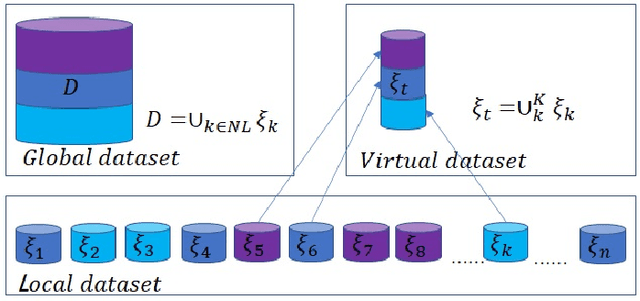Renhao Lu
Dual-Thresholding Heatmaps to Cluster Proposals for Weakly Supervised Object Detection
Sep 10, 2025Abstract:Weakly supervised object detection (WSOD) has attracted significant attention in recent years, as it does not require box-level annotations. State-of-the-art methods generally adopt a multi-module network, which employs WSDDN as the multiple instance detection network module and multiple instance refinement modules to refine performance. However, these approaches suffer from three key limitations. First, existing methods tend to generate pseudo GT boxes that either focus only on discriminative parts, failing to capture the whole object, or cover the entire object but fail to distinguish between adjacent intra-class instances. Second, the foundational WSDDN architecture lacks a crucial background class representation for each proposal and exhibits a large semantic gap between its branches. Third, prior methods discard ignored proposals during optimization, leading to slow convergence. To address these challenges, we first design a heatmap-guided proposal selector (HGPS) algorithm, which utilizes dual thresholds on heatmaps to pre-select proposals, enabling pseudo GT boxes to both capture the full object extent and distinguish between adjacent intra-class instances. We then present a weakly supervised basic detection network (WSBDN), which augments each proposal with a background class representation and uses heatmaps for pre-supervision to bridge the semantic gap between matrices. At last, we introduce a negative certainty supervision loss on ignored proposals to accelerate convergence. Extensive experiments on the challenging PASCAL VOC 2007 and 2012 datasets demonstrate the effectiveness of our framework. We achieve mAP/mCorLoc scores of 58.5%/81.8% on VOC 2007 and 55.6%/80.5% on VOC 2012, performing favorably against the state-of-the-art WSOD methods. Our code is publicly available at https://github.com/gyl2565309278/DTH-CP.
Steerable Pyramid Weighted Loss: Multi-Scale Adaptive Weighting for Semantic Segmentation
Mar 09, 2025Abstract:Semantic segmentation is a core task in computer vision with applications in biomedical imaging, remote sensing, and autonomous driving. While standard loss functions such as cross-entropy and Dice loss perform well in general cases, they often struggle with fine structures, particularly in tasks involving thin structures or closely packed objects. Various weight map-based loss functions have been proposed to address this issue by assigning higher loss weights to pixels prone to misclassification. However, these methods typically rely on precomputed or runtime-generated weight maps based on distance transforms, which impose significant computational costs and fail to adapt to evolving network predictions. In this paper, we propose a novel steerable pyramid-based weighted (SPW) loss function that efficiently generates adaptive weight maps. Unlike traditional boundary-aware losses that depend on static or iteratively updated distance maps, our method leverages steerable pyramids to dynamically emphasize regions across multiple frequency bands (capturing features at different scales) while maintaining computational efficiency. Additionally, by incorporating network predictions into the weight computation, our approach enables adaptive refinement during training. We evaluate our method on the SNEMI3D, GlaS, and DRIVE datasets, benchmarking it against 11 state-of-the-art loss functions. Our results demonstrate that the proposed SPW loss function achieves superior pixel precision and segmentation accuracy with minimal computational overhead. This work provides an effective and efficient solution for improving semantic segmentation, particularly for applications requiring multiscale feature representation. The code is avaiable at https://anonymous.4open.science/r/SPW-0884
Offline Goal-Conditioned Reinforcement Learning for Safety-Critical Tasks with Recovery Policy
Mar 04, 2024Abstract:Offline goal-conditioned reinforcement learning (GCRL) aims at solving goal-reaching tasks with sparse rewards from an offline dataset. While prior work has demonstrated various approaches for agents to learn near-optimal policies, these methods encounter limitations when dealing with diverse constraints in complex environments, such as safety constraints. Some of these approaches prioritize goal attainment without considering safety, while others excessively focus on safety at the expense of training efficiency. In this paper, we study the problem of constrained offline GCRL and propose a new method called Recovery-based Supervised Learning (RbSL) to accomplish safety-critical tasks with various goals. To evaluate the method performance, we build a benchmark based on the robot-fetching environment with a randomly positioned obstacle and use expert or random policies to generate an offline dataset. We compare RbSL with three offline GCRL algorithms and one offline safe RL algorithm. As a result, our method outperforms the existing state-of-the-art methods to a large extent. Furthermore, we validate the practicality and effectiveness of RbSL by deploying it on a real Panda manipulator. Code is available at https://github.com/Sunlighted/RbSL.git.
Auction Based Clustered Federated Learning in Mobile Edge Computing System
Mar 12, 2021



Abstract:In recent years, mobile clients' computing ability and storage capacity have greatly improved, efficiently dealing with some applications locally. Federated learning is a promising distributed machine learning solution that uses local computing and local data to train the Artificial Intelligence (AI) model. Combining local computing and federated learning can train a powerful AI model under the premise of ensuring local data privacy while making full use of mobile clients' resources. However, the heterogeneity of local data, that is, Non-independent and identical distribution (Non-IID) and imbalance of local data size, may bring a bottleneck hindering the application of federated learning in mobile edge computing (MEC) system. Inspired by this, we propose a cluster-based clients selection method that can generate a federated virtual dataset that satisfies the global distribution to offset the impact of data heterogeneity and proved that the proposed scheme could converge to an approximate optimal solution. Based on the clustering method, we propose an auction-based clients selection scheme within each cluster that fully considers the system's energy heterogeneity and gives the Nash equilibrium solution of the proposed scheme for balance the energy consumption and improving the convergence rate. The simulation results show that our proposed selection methods and auction-based federated learning can achieve better performance with the Convolutional Neural Network model (CNN) under different data distributions.
 Add to Chrome
Add to Chrome Add to Firefox
Add to Firefox Add to Edge
Add to Edge